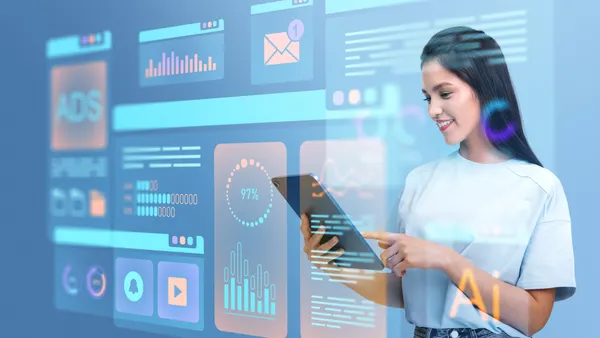From product development to sales, every aspect of business involves people. A business’s success depends on hiring the right individuals, placing them in the right roles, and equipping them with the right skills. To operate with efficiency and precision, employers require information about their people and business. Effective people analytics gives them the data insights they need to refine their recruiting methods, improve their employees’ performance, and optimize their learning and development programming.
For most organizations, however, these insights are often out of reach. Historically, it’s been incredibly challenging to access and analyze employee data. The roadblocks are so burdensome, in fact, that many organizations struggle to glean even basic insights, such as how many people they employ.
Recent technological developments are removing these barriers. With next-generation people analytics, employers have easy, intuitive access to information. Artificial intelligence (AI) proactively surfaces critical insights, enabling businesses to do more with their data.
“Organizations can now use people analytics to get better insights faster,” said Carrie Klauss, senior director of product marketing for SAP’s SuccessFactors. “Having that knowledge at your fingertips enables you to take action quicker than ever before.”
Inexhaustible information, inaccessible insights
Organizations rely on people analytics to make smart business decisions. While the data that fuels these decisions is abundant, it can be hard to access and even harder to make useful.
Consider the data generated by a single employee: There’s personal intel, recruiting information, performance history, learning records, and more. These categories of data generally exist in different places, so employers must bring the information together and “make it speak the same language” before they can use it. This job typically falls to an HR analyst. Once an analyst extracts data from the various silos and wrangles it into serviceable information, it could be out of date.
“To get any insight out of that process is a challenge,” Klauss explained.
These frustrations have led some HR teams to rely on analytics tools that sit outside of their human capital management (HCM) systems. While helpful, these tools require users to export and import data from various sources, either with an automated integration or manually. This means organizations are investing extra time, money, and resources to make sense of their own data.
One source, unlimited learnings
Thanks to recent developments in technology, the frustrations that once defined people analytics are now avoidable. Data can be easily accessible and fully reliable.
“Before, organizations had to pull data from different sources and harmonize it manually,” said Andrea Domhardt, product marketing for people analytics at SAP SuccessFactors. “Now, all of that can be automated so you have a single source of people data — up to date, always available, and kept intact with the business context that matters.”
This transformation allows organizations to dig deep into problem areas and potential opportunities with AI-driven insights and recommendations. For example, an HR analyst can use people analytics to probe employee turnover, revealing whether turnover is associated with a specific region, department or demographic. A talent leader can cross-reference the insights with other people data to investigate whether resignations could be influenced by pay or development opportunities. L&D leaders can likewise determine engagement and impact in learning and development, giving businesses insight into how such programs drive employee skills progression.
“Given the fact that data from across the business is now harmonized, multiple kinds of cross-references are now possible,” Domhardt explained.
Turning insights into impact — in real time
These innovations maximize the value of people analytics. With direct access to immediately useful information, HR leaders don’t need to waste time waiting on reports or decoding data. Instead, they can spend their time and energy putting insights into action.
This updated approach to people analytics enables HR to be an even better strategic partner to the business as a whole. With accurate, timely data, the department can be both proactive and predictive, reporting on the problems impacting a business from a people perspective and offering data-driven solutions.
“You can spot trends, driving factors, and action points,” Klauss indicated. “It allows you to get ahead of risk and change versus waiting and reacting to it.”
The value of people analytics is not limited to HR. Leaders across a business can cross-reference data from HR and, for example, finance, to understand the information within a specific context. These connections enable them to make informed decisions about business operations and workflows, such as the headcount needed or the budget for hiring.
Access next-generation analytics with People Intelligence
People analytics used to be painful. With instant, intuitive access to reliable data and AI-surfaced insights, people analytics now empowers organizations to make smarter decisions across the business. To learn how your organization can harness next-generation people analytics, attend SAP’s webinar on its new analytics solution, People Intelligence.










